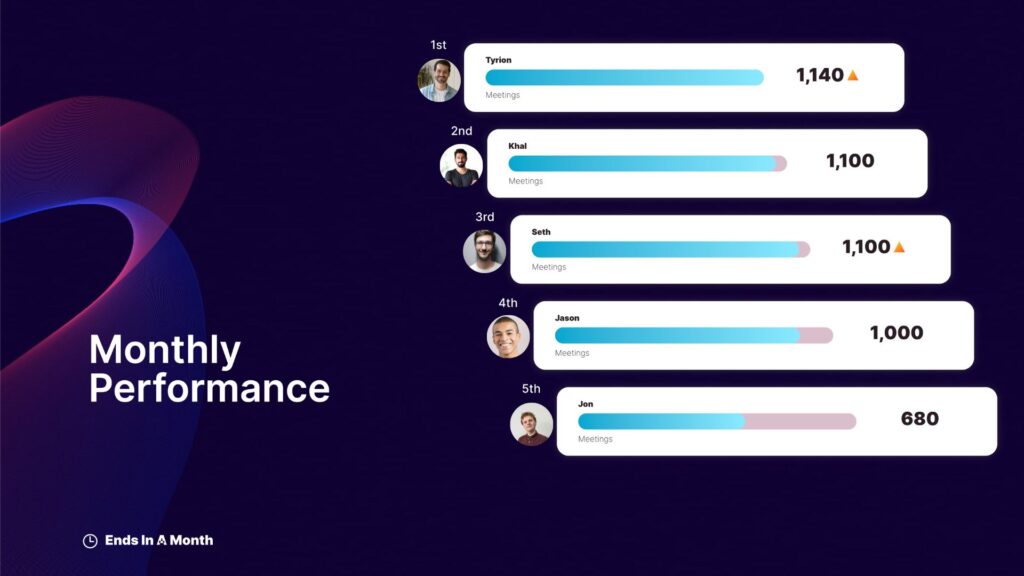Gamification SaaS: Sales Gamification Techniques, Best Practices, and Examples
SaaS products aim to implement gamification to drive user engagement, improve productivity, streamline processes, and boost employee engagement and motivation.
Whether it’s a CRM platform for your sales team, a project management tool for everyday use, or specialized software tailored to your industry, SaaS solutions are essential to modern businesses. Let’s explore how gamification elevates user engagement, allowing users to create a more enjoyable and productive experience.
Gamification helps businesses more actively engage their employees, users, and customers with the tools they use and tasks they have on their to-do lists. By using user feedback andincorporating game mechanics and elements of fun, businesses can ensure users are fully immersed in the experience.
You may be wondering: Why is gamifying the experience so essential for SaaS software? Studies suggest that game mechanics in the workplace can increase employee engagement by 60%. With the help of gamification elements, this software can keep your team motivated throughout the workday and inspire them to achieve more.
Let’s take a closer look at enterprise and gamification strategies collaboration tools and techniques commonly used by big-name SaaS companies. With this insight, you can find new ways to engage with your team and customers in a dynamic and innovative way.
How Gamification Creates a More Engaging and Productive SaaS Experience
Gamification is the process of adding gaming elements to a non-game process. With strategic gamification methods, you can motivate employees, boost customer engagement and the customer loyalty further and improve the overall experience for your team members and customers. It’s why is gamification such a powerful strategy to enhance software adoption and drive desired behaviors.
Gamification is widely used in SaaS to improve the usability of SaaS products, enhance and increase user engagement, and ensure product adoption in the workplace. The SaaS products you use daily are there to keep you organized and improve productivity.
If active users feel entertained and engaged with the SaaS product, it’s more likely to become an integral part of their everyday lives, which is a win-win situation for everyone. By making even routine tasks feel rewarding, implementing gamification here can transform the way users interact with your SaaS solution. For a simple gamification example, imagine if completing support tickets earned you experience points or unlocked new knowledge base access.

Gamification in SaaS: The Key to Engagement and Adoption
This increased engagement makes your SaaS product more enjoyable and fosters a deeper connection. Users who feel entertained and rewarded are more likely to fully adopt the software into their daily workflow. This creates a win-win scenario, driving both productivity and user satisfaction.
Gamifying the User Interaction
Studies suggest that websites with interactive content see conversion rates that are nearly six times higher than other websites. This boost in experiences and conversions demonstrates the power of gamification to enhance customer experience (UX) and drive more users complete their desired actions.
Why is that? Let’s break it down.
You clock in to start your work day. You look through your email, plan your day, and start writing down tasks you want to complete. While you work through your to-do list, at some point, your motivation will decrease.
What if the stakes were raised?
What if every day was a competition, or you knew in the back of your mind that you were working towards something bigger?
These are all gamification examples. Gamification aims to invite fun, interactive game mechanics, into your workday. These techniques keep your team engaged from 9 to 5 and push them to accomplish a shared goal.
When a gamification strategy is integrated into the SaaS products you use daily, you can make other usersfeel confident they are getting the most out of the experience.
Different types of Gamification Methods
When creating a SaaS product, businesses implement different game mechanics to improve product success and keep users engaged. With these game elements, they can enhance the experience and turn their product into an interactive experience that thrives on user engagement.
Here are a few common gamification tools:
Progress Bars
Rewards, Incentives, and Recognition
Interactive Learning
Visualization
Let’s take a closer look at how five successful SaaS companies use these techniques for their platform.
Boost User Engagement and Productivity: How Gamification Transforms the SaaS Customer Experience
Hubspot offers a comprehensive list of certification programs for all users called Hubspot Academy. Certification programs allow employees to learn valuable skills for email marketing, sales enablement, software, content marketing, and more. Your team can grow their professional knowledge and skill set with these certifications and unlock new opportunities for career advancement.
Hubspot uses badges to encourage individuals to complete their certification programs. For every course they complete and quiz they pass, they’ll receive a badge and certifications. The badges are social proof of their accomplishment that can be shared on their social media platforms, in Slack channels, and with their higher-up managers. This public recognition fosters a sense of pride and motivation.
Gamify Your Training: Drive Participation, Retention, and Results
By incorporating gamification into the certification program, Hubspot has found a way to improve the usability of its product, enhance user engagement, encourage active participation by users and provide each business with a suite of hands-on training courses at its disposal.
Every time someone shares a badge on LinkedIn, they also receive authentic brand exposure. Gamifying the learning experience makes it both rewarding and enjoyable rewarding users.
Badges are an excellent gamification technique that any business can implement in their workplace. Every time someone on your team meets their quota, completes in-house training courses, or goes above and beyond with their sales activities for the day, you can reward them with a badge. Points, badges, and incentives make the learning process more fun for new hires and keep them entertained in the onboarding process.
Spinify: Inspiring Better Performance and Positive Culture with Gamification Culture
Spinify is Sales Gamification software designed to improve performance and workplace culture. Using a combination of Leaderboards, Recognition, and Rewards, Spinify’s full gamification platform boosts data and performance visibility and motivates employees to hit their targets faster than ever.
Perfect for SaaS, Spinify’s competitions and corresponding leaderboards allow players to focus on their progress to the target and keep the highest and lowest performers in view. This approach induces a sense of urgency to the target while also promoting healthy, friendly competition between teammates.
Moreover, automated achievement celebrations and badges give the team something to strive for! For example, when a new deal is won, the responsible player will be announced to the whole team on social media.
This increased public acknowledgment of milestones, user progress, and achievements makes employees feel appreciated and recognized for their hard work.
Your Goals with Ease: Turn Sales into a Fun & Rewarding Game
Spinify keeps your team focused on achieving its KPIs and goals, turning even the most mundane tasks into an enjoyable, competitive adventure. Coupled with their world-class coaching features and comprehensive performance analytics, it’s never been easier or more enjoyable to improve staff performance and hit every target!
LinkedIn Premium Membership: Visualizing Progress
LinkedIn is a popular social media platform for working professionals. It also has a suite of paid features for recruiters and sales teams. The platform utilizes gamification to encourage users, keep individuals on track for their goals and ensure they get the most out of their paid service.
The premium membership uses award badges, progress bars, social interaction, and other curated content to incentivize its users to complete more and enhance user engagement. Every time a premium member logs into LinkedIn, they’ll see how many Inmail credits they have, gain access to interactive learning content, and visualize their success.
The platform also uses progress bars and other gamification techniques to encourage users to complete their profiles. The progress bar shows how close you are to achieving all-star profile status.
Linkedin’s gamification technique is visualization. If individuals can visualize their success, they are more likely to go the extra mile. If you didn’t see the progress bar at the top of the profile, you’d feel less inclined to finish creating your profile.
With visualization, your business can keep your team on track to meet its goals. When you meet with them during coaching sessions or help them build a roadmap to meet their long-term goals, you can help them see a clear path toward success with the same visualization techniques.
Salesforce: Improving the User Onboarding Experience
Salesforce is a Customer Relationship Management platform businesses use to keep track of prospects, sales activities, deals, and all other sale-related information. The platform utilizes several game mechanics like rewards, leaderboards, badges, and intuitive learning.
They created a user journey called Trailhead so that users can understand the ins and outs of the platform in a streamlined process. The platform rewarded users when they completed the Salesforce training.
Salesforce has turned the onboarding process into a fun and interactive experience, so users are more likely to retain the information from the onboarding and use it in the workplace.
With Trailhead, Salesforce turns its software into an easy-to-use software that values the customer experience. Customers who choose Salesforce as their CRM can feel confident about the onboarding process for their employees.
Freshdesk: Fuels Competition with Leaderboards
Who doesn’t love some fun, good-spirited competition? It’s a great way to motivate employees to do more throughout the workweek and keep them entertained.
Freshdesk is a customer service software that helps businesses improve customer engagement. This SaaS platform puts your team in the competitive spirit with a real-time leaderboard in the dashboard. Every time your customer service team clocks in to start their day, they’ll see everyone’s score.
With leaderboards, your team can visualize its success. They’ll know what they need to do if they want to outrank the rest of their coworkers or come up on top at the end of the week.
Asana: Celebrating Milestones
Asana is a project management tool that helps keep teams organized with ongoing projects. Their platform is set up to celebrate every big or small accomplishment. Every time someone completes a task, a unicorn will appear on the screen, and the project will disappear from their to-do list.
This visual reward system not only puts a smile on your team’s face but also motivates users to continue completing tasks on their list. Every completed project triggers a sense of accomplishment, making users feel positive about using Asana and increasing user loyalty.
While you may not be able to conjure unicorns for your team, implementing similar micro-celebrations and recognition techniques can remind employees you appreciate their hard work and dedication.
The Power to Encourage Users
Gamified elements, like Asana’s unicorns, provide a fun and lighthearted way to encourage users. By acknowledging progress and celebrating wins, you create a positive feedback loop that reinforces desired behaviors. This kind of immediate gratification can boost engagement and increase a sense of investment in your platform.
Implementing Enterprise Gamification to Boost Performance
Gamification is an invaluable tool that businesses can utilize to motivate users and make work more engaging and entertaining. With game design concepts, you can use the same techniques found in a video game and bring them into the workplace, motivating users, whether with a leaderboard, progress bar, or a point system. These gamified elements tap into our desire for achievement, fostering a sense of accomplishment that drives productivity.
The Psychology of Gamification
Gamification isn’t just about badges and points. It taps into core psychological motivators. Leaderboards spark healthy competition, progress bars visualize our advancement, and rewards trigger positive feedback loops within the brain. This translates into higher engagement not because work suddenly became a game, but because gamification elements satisfy our intrinsic need for progress, recognition, and a sense of control.
Beyond Entertainment: Real-World Results
While gamification makes work more enjoyable, the benefits extend far beyond mere fun. By aligning gamified elements with desired business outcomes, you can drive quantifiable results. This includes increased sales activity, faster onboarding, improved training completion rates, and even enhanced customer satisfaction scores. Gamification strategically links the actions you want users to take with the rewards they crave, creating a powerful cycle of motivation.
Tired of Low Engagement? Transform Your Workplace with Spinify
At Spinify, we make it easy to implement enterprise gamification SaaS techniques in the workplace. Our solution will help you coach your team, track their progress, visualize their success, enhance user engagement and create a culture where achievements are celebrated.
Book a personalized demo today and see how Spinify can help boost your team’s performance.



